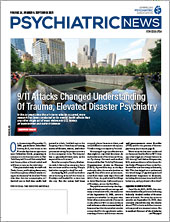Form FD-12.
A dreaded scenario for an outpatient psychiatrist is that of the unpredictable, resistant, recalcitrant patient who shows evidence of self-harm or potential harm to others, denies illness, and protests treatment.
In Washington, D.C., where I practiced, the essential tool for emergency hospitalization is the Form FD-12, “Application for Emergency Hospitalization.” When I need to complete an FD-12, my vigilance is heightened in anticipation of the patient’s disruption and violent behavior.
The alarm starts with a community complaint, the patient’s first step through the door, and his fiery words and intimidating demeanor. The crisis evaluation can be unsettling to the psychiatrist, to other patients, and to the entire practice setting. It is a situation that sharpens one’s mental reflexes, extending to domains of intellect and analysis that perhaps lay dormant when treating comfortable, predictable, stable patients. It tests the clinic’s emergency readiness and the system’s FD-12 flow and warns of inadequate follow-up that allowed the emergency.
Imagine the following: A silent drama unfolds before me. The patient’s rights and risks swirl in my head. I note the deterioration of appearance and clothing, and I struggle to engage him in decision-making despite his inability to cooperate, lack of insight, and ultrashort fuse. The moment of mutual negotiation vanishes, the threshold is crossed, my decision is clear: He must be sent to the ER. I assess the patient for substance use, medication compliance, delusions, psychosis, and volatility. He chatters as my fingers type notes into his electronic health record. My posture converts to one of clinical stealth in the best interest of my patient.
When I am given information from a third party that the patient poses a threat, I translate that danger to his current mental status. For example, the patient tells another staff person that he intends to kill his mother. I try to get the patient to repeat what he said, why, and in what words. Is he experiencing delusions or hallucinations?
The patient is seated by my side—restive and questioning my actions: What are you typing and why? He wants to leave. My office is not tiny, but it is small enough to increase my watchfulness, even my apprehension. My stomach tightens. I empathize with his own fears and suspicions, and I respect his physical space.
In my mind, I visualize the three essential components of the FD-12: “facts” that lead me to believe he is mentally ill, dangerous, and likely to harm self or others due to mental illness.
I seem calm. I do not leave my patient alone to confer with staff or use the phone. The only interaction is between the two of us, with no intermediary or interruptions. I am careful not to trigger him into a physical act, and I avoid gestures that might suggest a predator is about to swoop. He must not bolt into the street. I am aware of my tension, sweaty palms, and heavy cognitive load. For me, the drama is now one of quiet vigil and reflection of risks. In a Zen state of mindfulness, I coax and escort him to another room with staff who will tread slow and easy. Another calls the police.
My intimate contact with the patient is over, and the FD-12 beckons. I never complete the form in front of patients; its appearance sometimes provokes agitation and paranoia. My FD-12 must be incisive, concise, unequivocal, honest; I must precisely state my belief of the patient’s likeliness to harm himself or others. While FD-12 forms are also completed by community police and authorized agents, greater exactitude and diligence are expected of an M.D., whose remarks may be parsed by the ER psychiatrist and must stand up in court.
Time is of the essence. The form must be near completion before the police arrive: They can’t stand around, waiting. They are busy, and I must respect their time. Also, they might want to read the FD-12 before they engage with the patient.
The patient waits within his own world of suffering.
The police take over with professional courtesy, sensitivity, and compassion. They handcuff patients only when they think patients will be aggressive, unlike nonprotesting sick patients, who merely walk toward them and into the van.
I sigh with relief only after numbers and names and time are verified, data crisp and clear, with fidelity to the patient and the legal protocol. When I next see my patient—mercifully—he will have repressed the traumatic emotions of physician “betrayal” and move on. ■

